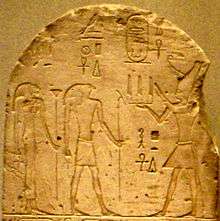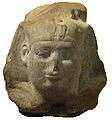Shabaka
| Shabaka | ||||||||||||||||||||||||||||||||||||||||||||||||||||||||||||||||||||||||||||||||||||||||||||||||||
|---|---|---|---|---|---|---|---|---|---|---|---|---|---|---|---|---|---|---|---|---|---|---|---|---|---|---|---|---|---|---|---|---|---|---|---|---|---|---|---|---|---|---|---|---|---|---|---|---|---|---|---|---|---|---|---|---|---|---|---|---|---|---|---|---|---|---|---|---|---|---|---|---|---|---|---|---|---|---|---|---|---|---|---|---|---|---|---|---|---|---|---|---|---|---|---|---|---|---|
 Donation stela of Shabaka, on display at the Metropolitan Museum of Art | ||||||||||||||||||||||||||||||||||||||||||||||||||||||||||||||||||||||||||||||||||||||||||||||||||
| Pharaoh | ||||||||||||||||||||||||||||||||||||||||||||||||||||||||||||||||||||||||||||||||||||||||||||||||||
| Reign | 721–707 or 706 B.C.E. (25th Dynasty) | |||||||||||||||||||||||||||||||||||||||||||||||||||||||||||||||||||||||||||||||||||||||||||||||||
| Predecessor | Piye | |||||||||||||||||||||||||||||||||||||||||||||||||||||||||||||||||||||||||||||||||||||||||||||||||
| Successor | Shebitku | |||||||||||||||||||||||||||||||||||||||||||||||||||||||||||||||||||||||||||||||||||||||||||||||||
| ||||||||||||||||||||||||||||||||||||||||||||||||||||||||||||||||||||||||||||||||||||||||||||||||||
| Consort | Qalhata, Mesbat, possibly Tabekenamun | |||||||||||||||||||||||||||||||||||||||||||||||||||||||||||||||||||||||||||||||||||||||||||||||||
| Children | Tantamani, Haremakhet, Piankharty, Isetemkheb[2] | |||||||||||||||||||||||||||||||||||||||||||||||||||||||||||||||||||||||||||||||||||||||||||||||||
| Father | Kashta | |||||||||||||||||||||||||||||||||||||||||||||||||||||||||||||||||||||||||||||||||||||||||||||||||
| Mother | Pebatjma | |||||||||||||||||||||||||||||||||||||||||||||||||||||||||||||||||||||||||||||||||||||||||||||||||
| Died | 707 or 706 B.C.E. | |||||||||||||||||||||||||||||||||||||||||||||||||||||||||||||||||||||||||||||||||||||||||||||||||
| Burial | el-Kurru | |||||||||||||||||||||||||||||||||||||||||||||||||||||||||||||||||||||||||||||||||||||||||||||||||
| Monuments | Shabaka Stone | |||||||||||||||||||||||||||||||||||||||||||||||||||||||||||||||||||||||||||||||||||||||||||||||||
Neferkare Shabaka (or Shabako) was a Kushite pharaoh of the Twenty-fifth dynasty of Egypt, who reigned from 721 BC–707/706 BC.[3]
Family
Shabaka is thought to be the son of King Kashta and Pebatjma, although a text from the time of Taharqa could be interpreted to mean that Shabaka was a brother of Taharqa and hence a son of Piye.
Shabaka's Queen Consort was Qalhata, according to Assyrian records, a sister of Taharqa. Shabaka and Qalhata were the parents of King Tantamani and most likely the parents of King Shebitku as well.[2]
It is possible that Queen Tabekenamun was a wife of Shabaka.[4] She is thought by some to be a wife of Taharqa.[2]
Shabaka's son Haremakhet became High Priest of Amun and is known from a statue and a fragment of a statue found in Karnak.[2] A lady named Mesbat is mentioned on the sarcophagus of Haremakhet and may be his mother.[4]
Shabaka is the father of at least two more children, but the identity of their mother is not known. Piankharty later became the wife of her (half-)brother Tantamani. She is depicted on the Dream Stela with him. Isetemkheb H likely married Tantamani as well. She was buried in Abydos, Egypt.[2]
Biography
Shabaka succeeded his brother Piye on the throne, and adopted the throne name of the 6th-dynasty ruler Pepi II. Shabaka's reign was initially dated from 716 BC to 702 BC by Kenneth Kitchen. However, new evidence indicates that Shabaka died around 707 or 706 BC because Sargon II (722–705 BC) of Assyria states in an official inscription at Tang-i Var (in Northwest Iran)—which is datable to 706 BC—that it was Shebitku, Shabaka's successor, who extradited Iamanni of Ashdod to him as king of Egypt.[5][6] This view has been accepted by many Egyptologists today such as Aidan Dodson,[7] Rolf Krauss, David Aston, and Karl Jansen-Winkeln[8] among others because there is no concrete evidence for coregencies or internal political/regional divisions in the Nubian kingdom during the Twenty-fifth Dynasty. This point was also stressed by Dan'el Kahn in a 2006 article.[9] All contemporary records suggest that the Nubian Pharaohs ruled Egypt with only a single king on the throne, while Taharqa states explicitly on one of his Kawa stelas that he assumed power only after the death of his brother, Shebitku.[10]
Shabaka's reign is significant because he consolidated the Nubian Kingdom's control over all of Egypt from Nubia down to the Delta region. It also saw an enormous amount of building work undertaken throughout Egypt, especially at the city of Thebes, which he made the capital of his kingdom. In Karnak he erected a pink granite statue of himself wearing the twin crowns of Egypt. Shabaka succeeded in preserving Egypt's independence from outside foreign powers--especially the Assyrian empire under Sargon II. The most famous relic from Shabaka's reign is the Shabaka stone which records several Old Kingdom documents that the king ordered preserved.[11] Also notable is the Shabaka Gate, a large stone door unearthed by archeologists in 2011 and believed to have guarded the room where the king's treasures were stored. Despite being relative newcomers to Egypt, Shabaka and his family were immensely interested in Egypt's past and the art of the period reflects their tastes which harked back to earlier periods. Shabaka would grant refuge to king Iamanni of Ashdod after the latter fled to Egypt following the suppression of his revolt by Assyria in 712 BC.
Death
Shabaka is assumed to have died in his 15th regnal year based on BM cube statue 24429, which is dated to Year 15, II Shemu day 11 of Shabaka's reign.[12] From the evidence of the Tang-i Var inscription, Shabaka was already dead by 707 or 706 BC.[13] He was buried in a pyramid at el-Kurru and was succeeded by his nephew Shebitku, Piye's son, following the Kushite tradition of succession from brother to brother, to son of the first brother. Shebitku would eventually be succeeded by Tantamuni, a son of Shabaka.
Image gallery
 Head of Shabaka from the Louvre
Head of Shabaka from the Louvre Statue of Shabaka from the Louvre
Statue of Shabaka from the Louvre Donation Stela from the Metropolitan Museum
Donation Stela from the Metropolitan Museum Large commemorative scarab of Shabaka
Large commemorative scarab of Shabaka
References
- ↑ King Shabako
- 1 2 3 4 5 Aidan Dodson & Dyan Hilton: The Complete Royal Families of Ancient Egypt. Thames & Hudson, 2004, ISBN 0-500-05128-3 p.237
- ↑ R. Krauss and D.A. Warburton, "Chronological Table for the Dynastic Period" in Erik Hornung, Rolf Krauss & David Warburton (editors), Ancient Egyptian Chronology (Handbook of Oriental Studies), Brill, 2006. p. 494
- 1 2 R. Morkot: The Black Pharaohs, Egypt's Nubian Rulers, London 2000, p. 205 ISBN 0-948695-24-2
- ↑ G. Frame, The Inscription of Sargon II at Tang-i Var, Orientalia 68 (1999), pp. 31-57
- ↑ Dan'el Kahn, "The Inscription of Sargon II at Tang-i Var and the Chronology of Dynasty 25," Orientalia 70 (2001), pp. 1–3
- ↑ Journal of Egyptian Archaeology 88 (2002) p.182
- ↑ Karl Jansen-Winkeln, "The Third Intermediate Period" in Erik Hornung, Rolf Krauss & David Warburton (editors), Ancient Egyptian Chronology (Handbook of Oriental Studies), Brill, 2006. pp. 258–259
- ↑ Kahn, Dan'el., Divided Kingdom, Co-regency, or Sole Rule in the Kingdom(s) of Egypt-and-Kush?, Egypt and Levant 16 (2006), pp. 275–291 online PDF
- ↑ Kawa Stela V, line 15
- ↑ Shabaka stone
- ↑ Kitchen, Kenneth A. (1996).The Third Intermediate Period in Egypt (1100–650 BC), 3rd edition (Warminster: Aris & Phillips), pp. 153-54
- ↑ Karl Jansen-Winkeln, "The Third Intermediate Period" in Erik Hornung, Rolf Krauss & David Warburton (editors), Ancient Egyptian Chronology (Handbook of Oriental Studies), Brill, 2006. p. 259
External links
 Media related to Shabaka at Wikimedia Commons
Media related to Shabaka at Wikimedia Commons
